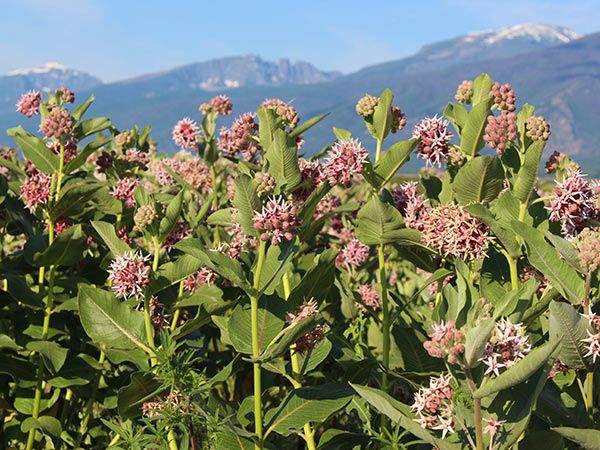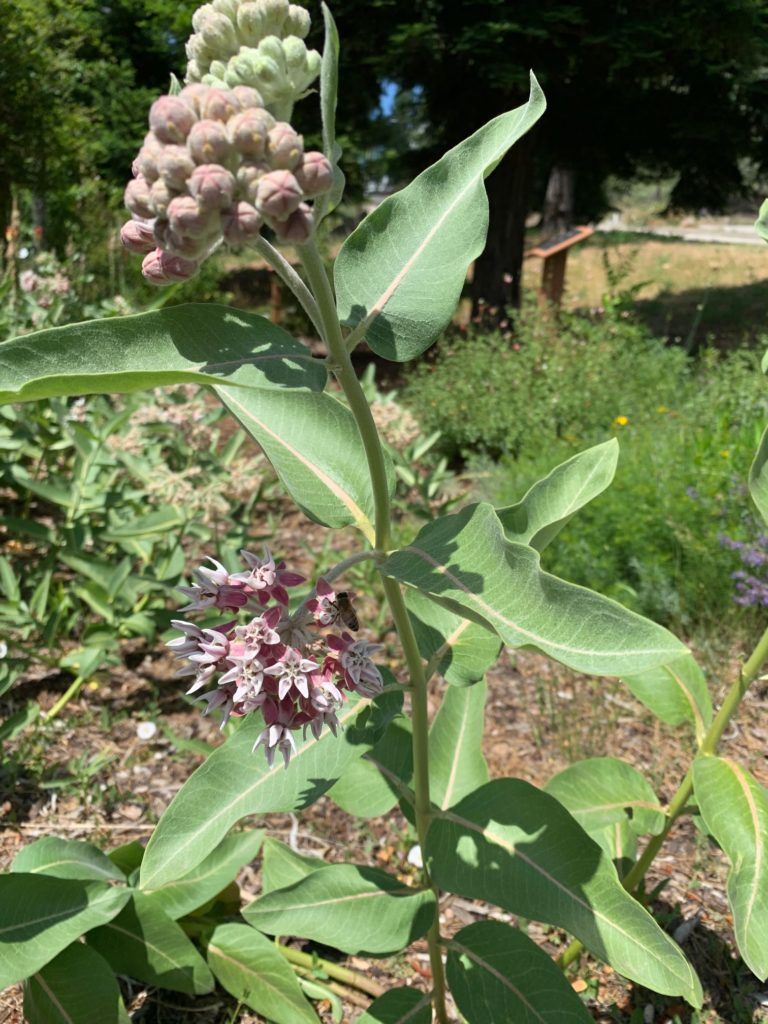Showy Milkweed (Asclepias Speciosa) is the Native Milkweed of the Western US. It is also known as “Creek Milkweed” because one finds Showy Milkweed in Nature along Creeks and Streams. Showy Milkweed has stems that grow to 1½ to 5 ft tall in summer. The gray-green leaves are opposite, 4 to 7 inches long, oval, and covered in velvety hairs. Stems and foliage exude milky latex sap when cut. Flowers are in loose clusters at the top of the branches and are rose-purple, aging to yellow. The plants flower from May to September and create 3 to 5 inches long seed pods that split down one side in Fall to release their reddish-brown, flat seeds. Each seed has a tuft of white, silky hairs that allows them to be dispersed by wind.
Showy Milkweed is the best Food Source for Monarch Caterpillars.
Showy Milkweed has large, fleshy leaves that provide plenty of food to Caterpillars. Showy Milkweed is superior to other Western US native milkweeds, like Narrow Milkweed or Hard Leaf Milkweed. However, these varieties produce very narrow leaves that feed caterpillars only after the plant matures.
In addition, the toxic milky sap of the Showy Milkweed is more potent than in other milkweed varieties, giving the Monarch Caterpillar perfect protection from predators.
Showy Milkweed is a Perennial Plant
Like most Milkweed Plants in the United States, Showy Milkweed is a perennial plant. (An exception is a Tropical Milkweed found in Florida and Hawaii that does not go dormant.)
Perennial means that the Showy Milkweed Leaves will turn yellow in late Fall and shortly after Fall off. After some time, the stem disappears as well. Many people believe the plant has died, but no! A perennial plant concentrate all energy in the root system from where the new plant shoots are coming from in Spring. The roots are also called rhizomes, which indicate the growth of new plants directly from the roots.
Showy Milkweed is considered a “weed,” but very fragile initially and likes Water and Sun.
Showy Milkweed grows in the Beginning relatively slow and is quite fragile. This difficulty is one reason why it is hard to find Nurseries that instead grow and sell Narrow Leaf Milkweed, which is easier and faster to develop. In addition, the roots of Showy Milkweed grow very long and need a deep pot to be started before one plants it in a sunny spot in the garden.
Because Showy Milkweed roots grow long and wide, one will find new plants many feet away from the original planting spot. If the plant has rooted well, it will spread out, and eventually, out of one plant, a dozen or so new plants will appear in a radius of 10′ by ten ′ feet.
Although Showy Milkweed can survive in dry conditions, it thrives in moist conditions. The best environment is well-drained soil in full sun, pastures, meadows, forest clearings, and creeks and streams, from sea level to about 6000 feet.
Native American’s usages for Showy Milkweed
The sap of Showy Milkweed was used by some desert tribes to heal sores and cuts and to cure warts and ringworm. The ripe seeds were ground and made into a salve for sores. Native Americans boiled the seeds and used the liquid to draw venom from rattlesnake bites. Tea made from rhizomes was a remedy for measles or coughs. It was also used as a wash to cure rheumatism. The rhizomes, mashed with water, created a poultice to reduce swelling.
Fiber: Native Americans used the stem fibers of Milkweed to make course cloth, string, cords, and ropes. At Zuni, NM, the silky seed floss is spun into yarn and woven into a unique fabric for dancers.
Today, Hybrids of Asclepias speciosa are being tested for commercial seed floss production as a hypo-allergenic substitute for goose down.
Which other Insects are benefitting from Showy Milkweed?
The abundant nectar of the Showy Milkweed flower attracts Pollinators like Hummingbirds, Honey Bees, Native Bees, and other beneficial insects. Although Milkweed is the only host plant for monarch butterflies, other Butterflies also choose this variety for their larva to develop. The caterpillars of the Queen (Danaus gilippus) and Viceroy Butterflies (Limenitis archippus) also can feed on Milkweed Leaves, giving them chemicals that make them distasteful to predators. Therefore, all caterpillars have similar orange and black patterns to warn predators.


